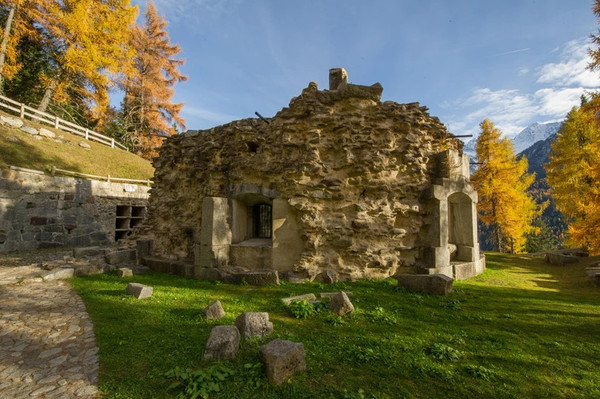Museum Forte Strino
Located just off today’s State Road 42, about four kilometres from Vermiglio and approximately six from the Tonale Pass. The Austro-Hungarian fortress was built between 1860 and 1861 at an altitude of 1,538 metres above sea level, with the purpose of controlling and defending the final stretch of road leading to the pass. The structure has a semicircular layout and is arranged over two levels. The first level contains three gun emplacements, while the second has four, all facing the Tonale road and the Vermiglio valley.
In addition to its combat chambers, which were equipped with six cannons, the fort featured a number of loopholes for close-range defence with machine guns. The lower section of the fortress also served as a roadblock (known as a tagliata). Although partially demolished, this part still serves as the main entrance to the building today.
The structure represents the first component of the so-called Tonale Fortification System. In the years following its construction and leading up to the outbreak of war in 1914, the area saw the development of several major military defence works, including four additional forts (Forte Mero, Forte Tonale or Zacarana, Forte Presanella or Pozzi, Forte Velon). The remains of these can still be visited on request and make for enjoyable and accessible hiking destinations.
Part of this impressive structure has now been converted into a museum, housing numerous artefacts and relics from the White War. These are the result of meticulous and often hazardous recovery and clearing efforts carried out by salvage workers from Vermiglio.
A visit to the fort begins with a short introductory video, followed by a series of backlit panels that not only present the broader themes of the First World War but also delve more deeply into local history—particularly the deportation of Vermiglio’s residents to Mitterndorf and the White War, which played out in the mountains surrounding the fort.
A modern touchscreen station allows visitors to explore further information about the fort and the many other fortifications in the Vermiglio area. It also offers a virtual trekking experience and the option to download recommended hiking routes.
For more information on opening hours, ticket prices, group offers, etc., please contact the Vermiglio Vacanze Tourist Office.
In addition to its combat chambers, which were equipped with six cannons, the fort featured a number of loopholes for close-range defence with machine guns. The lower section of the fortress also served as a roadblock (known as a tagliata). Although partially demolished, this part still serves as the main entrance to the building today.
The structure represents the first component of the so-called Tonale Fortification System. In the years following its construction and leading up to the outbreak of war in 1914, the area saw the development of several major military defence works, including four additional forts (Forte Mero, Forte Tonale or Zacarana, Forte Presanella or Pozzi, Forte Velon). The remains of these can still be visited on request and make for enjoyable and accessible hiking destinations.
Part of this impressive structure has now been converted into a museum, housing numerous artefacts and relics from the White War. These are the result of meticulous and often hazardous recovery and clearing efforts carried out by salvage workers from Vermiglio.
A visit to the fort begins with a short introductory video, followed by a series of backlit panels that not only present the broader themes of the First World War but also delve more deeply into local history—particularly the deportation of Vermiglio’s residents to Mitterndorf and the White War, which played out in the mountains surrounding the fort.
A modern touchscreen station allows visitors to explore further information about the fort and the many other fortifications in the Vermiglio area. It also offers a virtual trekking experience and the option to download recommended hiking routes.
For more information on opening hours, ticket prices, group offers, etc., please contact the Vermiglio Vacanze Tourist Office.
Reviews
This business activity has no reviews yet.
Write the first positive review, share your experience!
